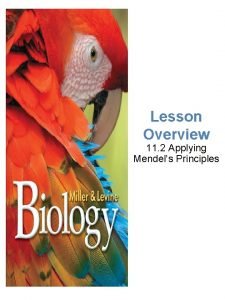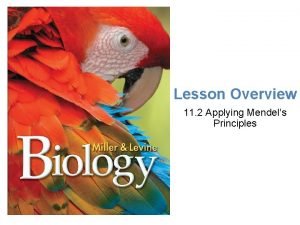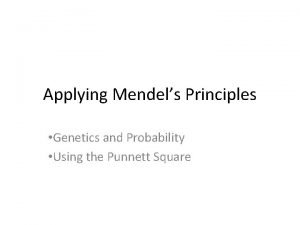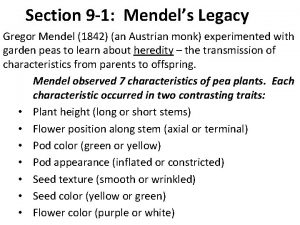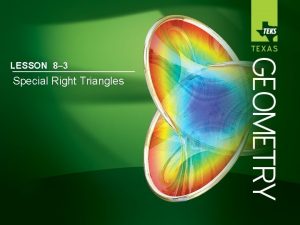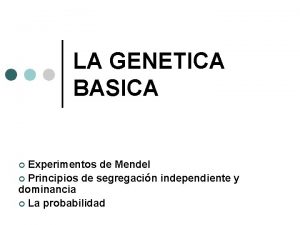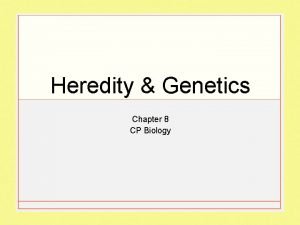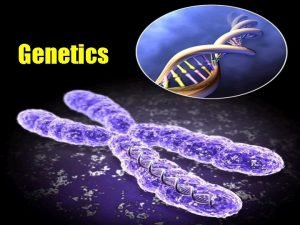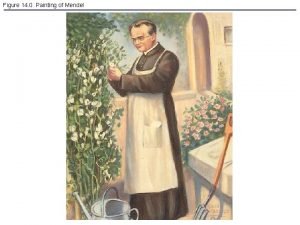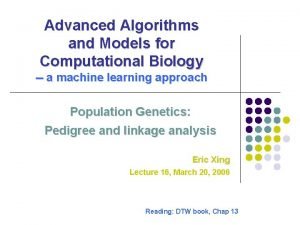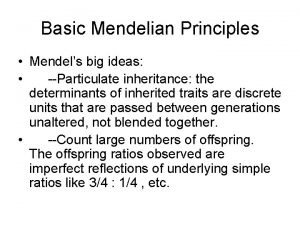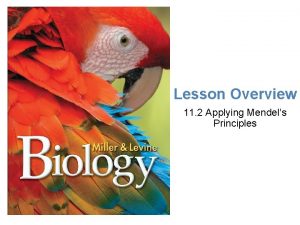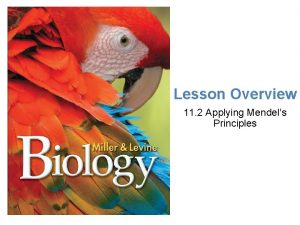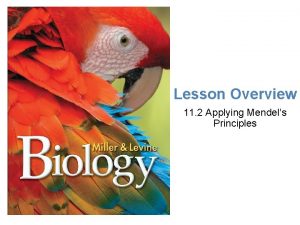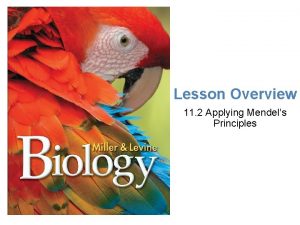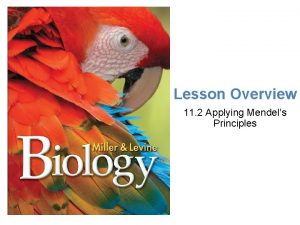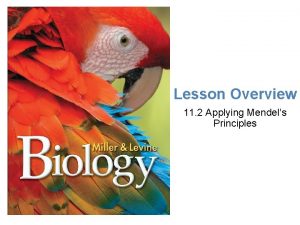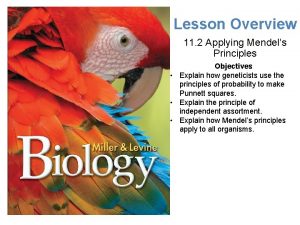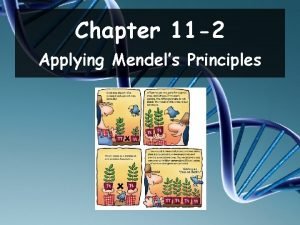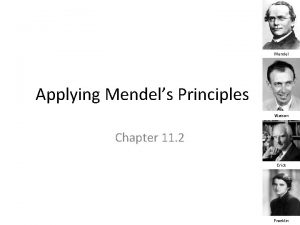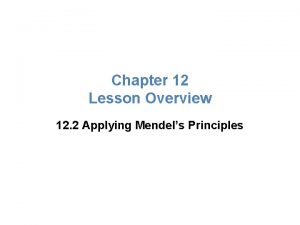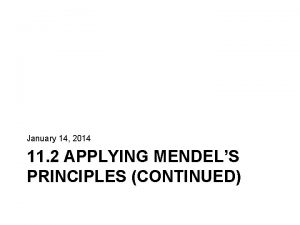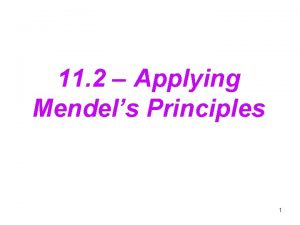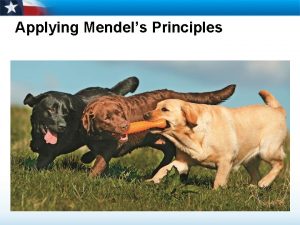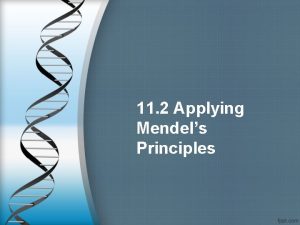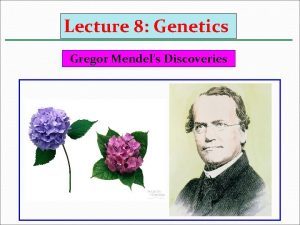Chapter 11 Section 2 Applying Mendels Principles Lesson























- Slides: 23

Chapter 11 Section 2 Applying Mendel’s Principles

Lesson Overview Applying Mendel’s Principles Probability and Punnett Squares Mendel realized that the principles of probability could be used to explain the results of his genetic crosses. Probability is the likelihood that a particular event will occur. For example, there are two possible outcomes of a coin flip: The coin may land either heads up or tails up. The chance, or probability, of either outcome is equal. Therefore, the probability that a single coin flip will land heads up is 1 chance in 2. This amounts to 1/2, or 50 percent

Lesson Overview Applying Mendel’s Principles Probability and Punnett Squares If you flip a coin three times in a row, what is the probability that it will land heads up every time? Each coin flip is an independent event, with a one chance in two probability of landing heads up. Therefore, the probability of flipping three heads in a row is: 1/2 × 1/2 = 1/8

Lesson Overview Applying Mendel’s Principles Probability and Punnett Squares As you can see, you have 1 chance in 8 of flipping heads three times in a row. Past outcomes do not affect future ones. Just because you’ve flipped 3 heads in a row does not mean that you’re more likely to have a coin land tails up on the next flip.

Lesson Overview Applying Mendel’s Principles Using Segregation to Predict Outcomes The way in which alleles segregate during gamete formation is every bit as random as a coin flip. Therefore, the principles of probability can be used to predict the outcomes of genetic crosses.

Lesson Overview Applying Mendel’s Principles Using Segregation to Predict Outcomes The predicted ratio— 3 dominant to 1 recessive— showed up consistently in Mendel’s experiments.

Lesson Overview Applying Mendel’s Principles Using Segregation to Predict Outcomes Organisms that have two identical alleles for a particular gene—TT or tt in this example—are said to be homozygous.

Lesson Overview Applying Mendel’s Principles Using Segregation to Predict Outcomes Organisms that have two different alleles for the same gene—such as Tt—are heterozygous.

Lesson Overview Applying Mendel’s Principles Probabilities Predict Averages Probabilities predict the average outcome of a large number of events. The larger the number of offspring, the closer the results will be to the predicted values. If an F 2 generation contains just three or four offspring, it may not match Mendel’s ratios. When an F 2 generation contains hundreds or thousands of individuals, the ratios usually come very close to matching Mendel’s predictions.

Lesson Overview Applying Mendel’s Principles Genotype and Phenotype Every organism has a genetic makeup as well as a set of observable characteristics. All of the tall pea plants had the same phenotype, or physical traits. They did not, however, have the same genotype, or genetic makeup.

Lesson Overview Applying Mendel’s Principles Genotype and Phenotype There are three different genotypes among the F 2 plants: Tt, TT, and tt. The genotype of an organism is inherited, whereas the phenotype is formed as a result of both the environment and the genotype. Two organisms may have the same phenotype but different genotypes.

Lesson Overview Applying Mendel’s Principles Using Punnett Squares One of the best ways to predict the outcome of a genetic cross is by drawing a simple diagram known as a Punnett squares allow you to predict the genotype and phenotype combinations in genetic crosses using mathematical probability.

Lesson Overview Applying Mendel’s Principles Independent Assortment Mendel wondered if the segregation of one pair of alleles affects another pair. Mendel performed an experiment that followed two different genes as they passed from one generation to the next. Because it involves two different genes, Mendel’s experiment is known as a two-factor, or dihybrid, cross. Single-gene crosses are monohybrid crosses.

Lesson Overview Applying Mendel’s Principles The Two-Factor Cross: F 1 Mendel crossed true-breeding plants that produced only round yellow peas with plants that produced wrinkled green peas.

Lesson Overview Applying Mendel’s Principles The Two-Factor Cross: F 1 The round yellow peas had the genotype RRYY, which is homozygous dominant.

Lesson Overview Applying Mendel’s Principles The Two-Factor Cross: F 1 The wrinkled green peas had the genotype rryy, which is homozygous recessive.

Lesson Overview Applying Mendel’s Principles The Two-Factor Cross: F 1 All of the F 1 offspring produced round yellow peas. These results showed that the alleles for yellow and round peas are dominant over the alleles for green and wrinkled peas. The Punnett square shows that the genotype of each F 1 offspring was Rr. Yy, heterozygous for both seed shape and seed color.

Lesson Overview Applying Mendel’s Principles The Two-Factor Cross: F 2 Mendel then crossed the F 1 plants to produce F 2 offspring.

Lesson Overview Applying Mendel’s Principles The Two-Factor Cross: F 2 Mendel observed that 315 of the F 2 seeds were round and yellow, while another 32 seeds were wrinkled and green—the two parental phenotypes. But 209 seeds had combinations of phenotypes, and therefore combinations of alleles, that were not found in either parent.

Lesson Overview Applying Mendel’s Principles The Two-Factor Cross: F 2 The alleles for seed shape segregated independently of those for seed color. Genes that segregate independently—such as the genes for seed shape and seed color in pea plants—do not influence each other’s inheritance.

Lesson Overview Applying Mendel’s Principles The Two-Factor Cross: F 2 Mendel’s experimental results were very close to the 9: 3: 3: 1 ratio that the Punnett square shown predicts. Mendel had discovered the principle of independent assortment. The principle of independent assortment states that genes for different traits can segregate independently during gamete formation.

Lesson Overview Applying Mendel’s Principles A Summary of Mendel’s Principles At the beginning of the 1900 s, American geneticist Thomas Hunt Morgan decided to use the common fruit fly as a model organism in his genetics experiments. The fruit fly was an ideal organism for genetics because it could produce plenty of offspring, and it did so quickly in the laboratory.

Lesson Overview Applying Mendel’s Principles A Summary of Mendel’s Principles Before long, Morgan and other biologists had tested every one of Mendel’s principles and learned that they applied not just to pea plants but to other organisms as well. The basic principles of Mendelian genetics can be used to study the inheritance of human traits and to calculate the probability of certain traits appearing in the next generation.
 Chapter 12 lesson 2 applying mendels principles
Chapter 12 lesson 2 applying mendels principles 11.2 applying mendel's principles
11.2 applying mendel's principles Chapter 12 lesson 2 applying mendel's principles
Chapter 12 lesson 2 applying mendel's principles Chapter 12 lesson 2 applying mendels principles
Chapter 12 lesson 2 applying mendels principles Applying mendels principles
Applying mendels principles Applying mendels principles
Applying mendels principles Gregor mendels principles of genetics apply to
Gregor mendels principles of genetics apply to Section 9-1 review mendels legacy
Section 9-1 review mendels legacy Types of pop in orthopedics
Types of pop in orthopedics Applying properties of similar figures
Applying properties of similar figures 5-8 applying special right triangles
5-8 applying special right triangles 5-8 practice a applying special right triangles
5-8 practice a applying special right triangles Lesson 8-3 special right triangles answers
Lesson 8-3 special right triangles answers Side side side similarity
Side side side similarity Gregor mendel plant
Gregor mendel plant Ejemplo de las leyes de mendel
Ejemplo de las leyes de mendel Mendels law
Mendels law Law of segregation and independent assortment
Law of segregation and independent assortment Mendels law of segregation states that
Mendels law of segregation states that Mendels law
Mendels law Mendels two laws
Mendels two laws Mendel's first law
Mendel's first law Mendels laws
Mendels laws Mendels fabric
Mendels fabric

